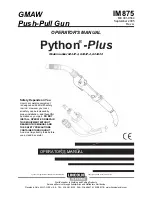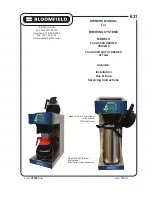
TitanMig Pulse 270/3500/5000 Operators Manual
Issue. A 0516
28
The correct shielding gas can alter productivity in GMAW by contributing to.
Correct weld sizes, to reduce over welding
Lower spatter levels, to increase welding speed and reduce clean-up
Reduced welding defects which reduces rework time
Reduced fume levels, to improve OH&S and worker comfort, increases productivity
Shielding gases have a strong influence over..
Stability of the arc
The shape of the weld bead/face
Mechanical properties of the weld
Cost efficiency of the welding process being used
Control of fume generation rates
Gases used in Shielding Gas Formulations
Argon
The tendency for argon to produce a “Wine Glass” penetration profile can make it difficult to ensure
complete fusion of the weld especially if “Arc Wander” is occurring.
For GMAW applications small additions of oxygen or carbon dioxide will assist in eliminating “Arc
Wander” by producing a uniformly oxidized surface for the arc root to “Anchor” to. The addition of
helium produces a broader and deeper fusion profile.
Carbon Dioxide CO2
The first shielding gas used for GMAW, MIG welding.
Spray transfer using GMAW cannot be achieved with carbon dioxide.
At low currents a good dip transfer mode can be obtained.
At high currents the transfer mode is globular and significant spatter is produced
Carbon Dioxide is less than ideal for use alone as a shielding gas but it is an essential ingredient of
most GMAW shielding mixtures.
High Carbon Dioxide (18 to 23%) mixtures are particularly suited to welding steels which are coated
with paint, primers and other surface contaminants, or where higher penetration is required.
Helium
Rarely used alone as a shielding gas.
Completely inert.
Lighter than air therefore less efficient as a shield.
High ionization potential which can cause arc initiation problems.
Essential ingredient for many shielding gas mixtures.
Helium rich shielding gas mixtures provide excellent weld fusion characteristics for GMA welding
applications. The high heat input obtained by using helium produces a hot arc and allows for high
deposition welding.
Oxygen
Oxygen is never used as a shielding gas on its own.
Oxygen is a vital component in many mixtures and performs two main functions…
It aids stability within the arc ionizing at a similar level to argon and influences the arc rooting
characteristics by producing a uniform oxide layer on the electrode and work piece.
It also reduces the surface tension of the metal droplets and the molten weld pool.
The benefits of these two functions are reduced wire losses as a result of spatter and the more
efficient use of deposited metal due to reduced reinforcement (weld metal build-up).
Summary of Contents for TitanMig Pulse 2700
Page 2: ...TitanMig Pulse 2700 3500 5000 Operators Manual Issue A 0516 ...
Page 36: ...TitanMig Pulse 270 3500 5000 Operators Manual Issue A 0516 32 4T Special 2T ...
Page 53: ...TitanMig Pulse 2700 3500 5000 Operators Manual Issue A 0516 49 ...
Page 65: ...TitanMig Pulse 2700 3500 5000 Operators Manual Issue A 0516 61 6 0 Electrical Diagram ...
Page 70: ...TitanMig Pulse 2700 3500 5000 Operators Manual Issue A 0516 66 ...
Page 71: ...TitanMig Pulse 2700 3500 5000 Operators Manual Issue A 0516 67 ...















































